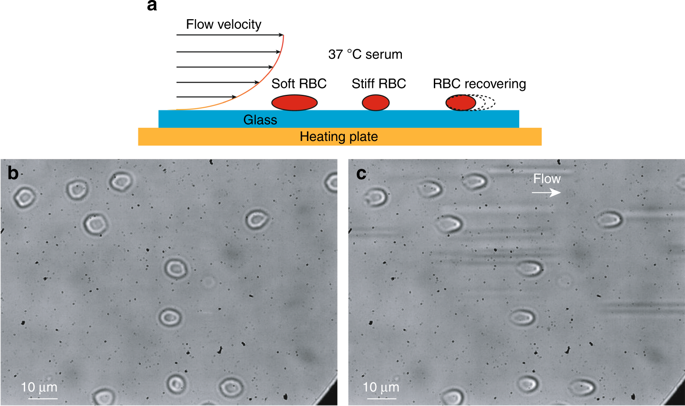Microsystems & Nanoengineering ( IF 7.3 ) Pub Date : 2019-11-04 , DOI: 10.1038/s41378-019-0097-7 Zhensong Xu 1 , Wenkun Dou 1 , Chen Wang 2, 3 , Yu Sun 1, 4, 5

|
In transfusion medicine, there has been a decades-long debate about whether the age of stored red blood cells (RBCs) is a factor in transfusion efficacy. Existing clinical studies investigating whether older RBCs cause worse clinical outcomes have provided conflicting information: some have shown that older blood is less effective, while others have shown no such difference. The controversial results could have been biased by the vastly different conditions of the patients involved in the clinical studies; however, another source of inconsistency is a lack of understanding of how well and quickly stored RBCs can recover their key parameters, such as stiffness and ATP concentration, after transfusion. In this work, we quantitatively studied the stiffness and ATP recovery of stored RBCs in 37 °C human serum. The results showed that in 37 °C human serum, stored RBCs are able to recover their stiffness and ATP concentration to varying extents depending on how long they have been stored. Fresher RBCs (1–3 weeks old) were found to have a significantly higher capacity for stiffness and ATP recovery in human serum than older RBCs (4–6 weeks old). For instance, for 1-week-old RBCs, although the shear modulus before recovery was 1.6 times that of fresh RBCs, 97% of the cells recovered in human serum to have 1.1 times the shear modulus of fresh RBCs, and the ATP concentration of 1-week-old RBCs after recovery showed no difference from that of fresh RBCs. However, for 6-week-old RBCs, only ~70% of the RBCs showed stiffness recovery in human serum; their shear modulus after recovery was still 2.1 times that of fresh RBCs; and their ATP concentration after recovery was 25% lower than that of fresh RBCs. Our experiments also revealed that the processes of stiffness recovery and ATP recovery took place on the scale of tens of minutes. We hope that this study will trigger the next steps of comprehensively characterizing the recovery behaviors of stored RBCs (e.g., recovery of normal 2,3-DPG [2,3-Diphosphoglycerate]and SNO [S-nitrosation] levels) and quantifying the in vivo recovery of stored RBCs in transfusion medicine.
中文翻译:

血清中储存的红细胞的硬度和 ATP 恢复
在输血医学中,关于储存红细胞 (RBC) 的年龄是否是输血效果的一个因素存在长达数十年的争论。现有的临床研究调查陈旧的红细胞是否会导致更差的临床结果,但提供了相互矛盾的信息:一些研究表明陈旧的血液效果较差,而另一些则没有显示出这种差异。由于参与临床研究的患者的病情差异巨大,有争议的结果可能会产生偏差。然而,不一致的另一个原因是缺乏对储存红细胞在输血后如何良好和快速地恢复其关键参数(例如硬度和 ATP 浓度)的了解。在这项工作中,我们定量研究了 37°C 人血清中储存的红细胞的硬度和 ATP 回收率。结果表明,在37°C的人血清中,储存的红细胞能够不同程度地恢复其硬度和ATP浓度,具体取决于它们储存的时间。研究发现,较新鲜的红细胞(1-3 周龄)比较老的红细胞(4-6 周龄)具有显着更高的硬度和人血清中 ATP 恢复能力。例如,对于1周龄的红细胞,虽然回收前的剪切模量是新鲜红细胞的1.6倍,但在人血清中回收的细胞中97%的剪切模量是新鲜红细胞的1.1倍,并且ATP浓度为恢复后1周龄的红细胞与新鲜红细胞没有差异。然而,对于 6 周龄的红细胞,只有约 70% 的红细胞在人血清中表现出硬度恢复;恢复后的剪切模量仍是新鲜红细胞的2.1倍;回收后的ATP浓度比新鲜红细胞低25%。 我们的实验还表明,硬度恢复和ATP恢复的过程发生在数十分钟的范围内。我们希望这项研究将触发下一步,全面表征储存红细胞的恢复行为(例如恢复正常的 2,3-DPG [2,3-二磷酸甘油酸] 和 SNO [S-亚硝化] 水平)并量化输血医学中储存的红细胞的体内回收。











































 京公网安备 11010802027423号
京公网安备 11010802027423号